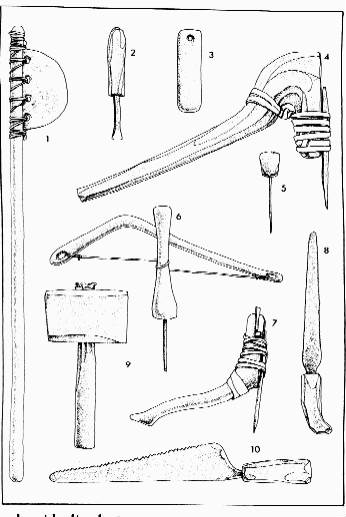
1. Axe
2. Chisel
3. Hone for sharpening tools
4. Adz
5. Bradawl
6. Bowdrill
7. Adz
8. Small handsaw
9. Mallet
10. Saw
Jesus was a carpenter (Mark 6:3), and as a result the work of a carpenter in Bible times has been some what idealized. Carpentry was a rough, tough job that demanded a great deal of physical strength and endurance as well as great skill. There were two aspects to the carpenter's work: firstly building and secondly the making of smaller objects that included furniture.
Until the Romans invented the arched roof, roofs were constructed by laying timber beams from wall to wall and filling in the gaps with matting that was plastered down with mud. The carpenter had to cut down trees and square up the logs so that they could be used as beams. This was done either with a hand adz (axe-like tool used primarily for shaping wood) or by sawing the length with a primitive saw. Either way was hard physical work. Axe heads were made of bronze (later of iron) and were lashed to a shaft. The bluntness of the edge and relatively insecure fastening ensured that the head fairly regularly came off the shaft. This happening was given as an example of manslaughter tin Deuteronomy 19:5. If the head was lost it was a disaster because of the cost of replacement (2 Kings 6:5). Saw blades were initially made from ribbon flints set in a wooden frame, and it took two men working either side to saw through a tree trunk. Later, metal blades were used, and the teeth arranged so that they cut on the "pull" stroke. The saw is mentioned in Isaiah 41:15 alongside the axe.

|
The Carpenter's Tools
1. Axe
|
Because the Jews had been a seminomadic people, carpentry had not been one of their developed skills. The standard of carpentry in Canaan in general therefore went down noticeably after the Israelite occupation, until the Phoenicians were called in to help (1 Chronicles 14:1). They were expert carpenters and built their trading fleet on this basis. In loaning their skills for the building of Solomon's Temple and other public buildings, they taught the Jews many of their skills, which included paneling, cladding, and carving (1 Kings 5:18). Although the Hews adopted carpentry so that their work is described by Isaiah as involving the use of measuring line, marker, chisels (possibly plane), and compass (Isaiah 44:13), and they were skilled enough to be taken into exile at the destruction of the Temple, by Nebuchadnezzar, their work still deteriorated when their alliance with Phoenicia was concluded.
The carpenter also undertook many smaller jobs, working on the ground outside his dwelling; benches were not used until Roman times. Doors, door frames, window lattices, and locks were made for buildings, and stools, low tables, and chests for inside the home. Agricultural implements such as Yokes, ploughs, and shovels were also part of the carpenter's work. The fact that tools were relatively crude meant that a good finish was an extremely skilled task. The hammer (Judges 5:26) was normally a piece of stone. The nails used to fasten together pieces of wood (Jeremiah 10:4) were made first of bronze and later of iron. Holes were bored with an awl, although its use in the Bible is confined to making holes in earlobes (Exodus 21:6; Deuteronomy 15:17).

| The carpenter's workshop. Notice many of the tools shown in the picture above are in this picture. The carpenter is making a cartwheel, while his young son is making part of a winnowing fork. |
(The end)